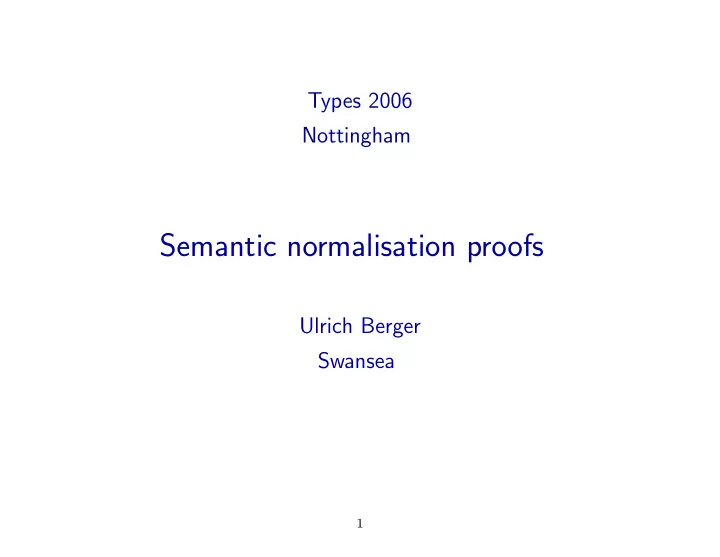

Types 2006 Nottingham Semantic normalisation proofs Ulrich Berger Swansea 1
Basic idea Interpret λ -terms with recursively defined constants in a domain model such that [ M ] � = ⊥ implies SN( M ) 2
Running example G¨ odel’s system T Simply typed λ -calculus with primitive recursion in all types: R x f 0 �→ x R x f S( k ) �→ f k (R x f k ) 3
Main components of the method Basic SN : If A is recursion free, then SN( A ) . Continuity: [ M ] = � n [ M n ] where M n := M [R n / R] and R n +1 x 0 �→ x R n +1 x f S( k ) �→ f k (R n x f k ) Strictness: If [ A ] � = ⊥ , then R 0 �∈ A (note [R 0 ] = ⊥ ). [ M ] � = ⊥ implies SN( M ) : [ M ] � = ⊥ : M → M ′ → . . . A recursion free, [ A ] � = ⊥ : A → A ′ → . . . 4
Applications G¨ odel’s T: Suffices to show that all terms are total and hence � = ⊥ . Note that totality is a semantic analogue to the method of reducibility candidates. The method can also be applied to prove normalisation w.r.t. restriced reduction: Make operators strict only at argument places where reduction is allowed. Bar recursion (Spector, Berardi/Bezem/Coquand): Φ s = if Y ˆ s < | s | then Hs else Gs ( λx. Φ( s ∗ x )) Ψ p = Y ( λk. if p ↓ k then p [ k ] else Gk ( λx. Ψ( p ∗ ( k, x ))) 5
Variant by Coquand and Spiwack In an algebraic domain we have � [ M ] = { U finite | U ⊑ [ M ] } The relation M : U : ⇔ U ⊑ [ M ] has an inductive definition similar to the typing rules for intersection types. In fact, an adaptation of the usual candidate method yields: Theorem (Coquand/Spiwack). If M : U , then SN( M ) . Note that no basic SN assumption is made. 6
Comparison Coquand/Spiwack • The candidate proof is done once and for all. • For a specific type system it suffices to prove totality (technically easier than candidate method; amounts to embedding the system into intersection types). • Suitable for formalisation in type theory. B • Does not include termination proof for underlying type system. • More abstract and hence open to systems other than typed λ -calculi ( → CSL’05). 7
Conclusion • Termination proof for a recursion scheme is reduced to a semantic totality argument, i.e. the intuitive raison d’ˆ etre for the scheme. • Continuity (magically) reduces a complicated recursion to a simple ω -iteration. • Further work: – Relax the syntactic restrictions on rewrite rules, allowing e.g. ( x + y ) + z �→ x + ( y + z ) – Corecursion – Dependent types ( → Coquand/Spiwack) – Abstract from λ -calculus to more general systems. 8
References [1] C. Spector. Provably recursive functionals of analysis: a consistency proof of analysis by an extension of principles in current intuitionistic mathematics. In F. D. E. Dekker, editor, Recursive Function Theory: Proc. Symposia in Pure Mathematics , volume 5, pages 1–27. American Mathematical Society, Providence, Rhode Island, 1962. [2] W.W. Tait. Normal form theorem for barrecursive functions of finite type. In J.E. Fenstad, editor, Proceedings of the Second Scandinavian Logic Symposium , pages 353–367. North–Holland, Amsterdam, 1971. [3] H. Vogel. Ein starker Normalisationssatz f¨ ur die barrekursiven Funktionale. Archive for Mathematical Logic , 18:81–84, 1985. 9
[4] G. D. Plotkin. LCF considered as a programming language. Theoretical Computer Science , 5:223–255, 1977. [5] M. Bezem. Strong normalization of barrecursive terms without using infinite terms. Archive for Mathematical Logic , 25:175–181, 1985. [6] J. van de Pol and H. Schwichtenberg. Strict functionals for termination proofs. In M. Dezani-Ciancaglini and G. Plotkin, editors, Typed Lambda Calculi and Applications , volume 902 of LNCS , pages 350–364. Springer Verlag, Berlin, Heidelberg, New York, 1995. [7] F. Blanqui, J-P. Jouannaud, and M. Okada. The calculus of algebraic constructions. In P. Narendran and M. Rusinowitch, editors, Proceedings of RTA’99 , number 1631 in LNCS, pages 301–316. Springer Verlag, Berlin, Heidelberg, New York, 1999. 10
[8] S. Berardi, M. Bezem, and T. Coquand. On the computational content of the axiom of choice. Journal of Symbolic Logic , 63(2):600–622, 1998. [9] T. Coquand and A. Spiwack. Proof of strong normalisation using domain theory. 2006. [10] B. A computational interpretation of open induction. In F. Titsworth, editor, Proceedings of the Ninetenth Annual IEEE Symposium on Logic in Computer Science , pages 326–334. IEEE Computer Society, 2004. [11] B., Strong normalization for applied lambda calculi. Logical Methods in Computer Science 1(2), 1–14, 2005. [12] B., An abstract strong normalization theorem. Proceedings of CSL’05, Oxford, LNCS 3634, 2005. 11
Recommend
More recommend